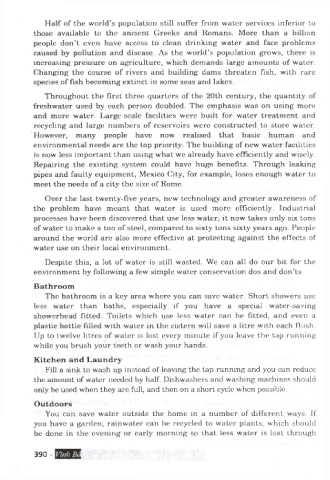Page 389 - Tài Liệu Ôn Thi THPT Quốc Gia Môn Tiếng Anh
P. 389
Half of the world’s population still suffer from water Services iníerior to
those available to the ancient Greeks and Romans. More than a billion
people don’t even have access to clean drinking water and face problems
caused hy pollution and disease. As the world’s population grows, there is
increasing pressure on agriculture, which demands large amounts of water.
Changing the course of rivers and building dams threaten físh, with rare
species of fish becoming extinct in some seas and lakes.
Throughout the íírst three quartcrs of the 20th century, the quantity of
freshwater used by each person doubled. The emphasis was on using more
and more water. Large-scale facilities were built for water treatment and
recycling and large numbers of rcservoirs wore constructed to store water.
However, many people have now realised that basic human and
environmental needs are the top priority. The building of new water facilities
is now less important than using what we already have eíĩiciently and wisely.
Repairing the existing System could have huge beneíĩts. Through leaking
pipes and faulty equipment, Mexico City, for example, loses enough water to
meet the needs of a city the size of Rome.
Over the last twenty-fíve years, new technology and greater avvareness of
the problem have meant that water is used more eữĩciently. Industrial
processes have been discovered that use less water; it now takes only six tons
of water to make a ton of Steel, compared to sixty tons sixty years ago. People
around the world are also more effective at protesting against the eíTects of
water use on their local environment.
Despite this, a lot of water is still wasted. We can all do our bit for the
environment hy following a few simple vvater conservation dos and don’ts.
Bathroom
The bathroom is a key area where you can save water. Short showers use
less water than baths, especially if you have a special water-saving
showerhead íĩtted. Toilets which use less water can be íĩtted, and even a
plastic bottle filled with water in the cistern will save a litre with each ílush.
Up to twelve litres of water is lost every minute if you leave the tap running
while you brush your teeth or wash your hands.
Kitchen and Laundry
Fill a sink to wash up instead of leaving the tap running 2ind you can reduce
the amount of water needed hy half. Dishw2ishers and washing machines shoiild
only be \ised when they are full, and then on a short cycle when possible.
Outdoors
You can save water outside the home in a number of different ways. If
you have a garden, rainwater can be recycled to water plants, which should
be done in the evening or early morning so that less water is lost through
390- \'7nh Bá

